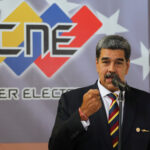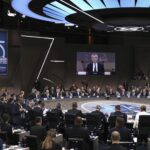Summary by Geopolist | Istanbul Center for Geopolitics:
“The Russian Central Bank’s Frozen Assets: A ‘Godsend’ for Kyiv’s Military Assistance?”
The European Union’s recent decision to allocate extraordinary revenues derived from frozen Russian Central Bank assets towards military assistance for Ukraine represents not only a demonstration of strong political will but also a potential mechanism to circumvent existing limitations in EU decision-making processes.
The Council’s decision
During a press conference following the Foreign Affairs Council on 24 June, High Representative Josep Borrell elucidated the Council’s decisions, including the adoption of the fourteenth sanctions package against Russia. Notably, Borrell emphasised what he termed the “most important” agenda item: a political agreement on the legal framework for utilising revenues from immobilised Russian assets.[1] While specific details were not extensively elaborated upon, Borrell disclosed that the available funds were projected to reach 1.4 billion euros by July, with an additional billion euros anticipated by year’s end. The High Representative further delineated the priorities for fund allocation, namely munitions, missiles, air defence systems and support for Ukraine’s defence industry, indicating also a shift in acquisition methods from partial reimbursements to member states to direct purchases from the European and Ukrainian defence industries, while granting flexibility for the global marketplace.
The crucial aspect of this decision, however, lies in the manner of its adoption. Borrell acknowledged that one member state – implicitly understood to be Hungary – opposed this decision, consistent with its opposition to various measures on this matter over the past 18 months, including the eighth tranche of reimbursements under the European Peace Facility (EPF), valued at approximately 6 billion euros. Nevertheless, Borrell asserted that the Council had identified a legal means to circumvent this “structural difficulty”.
The EPF and its structural limits
To contextualise this development, a brief background may be helpful. The EPF, established in March 2021, was designed with two primary objectives: to enhance funding mechanisms for EU missions and to enable military assistance measures beyond the African continent, including direct arms supplies. Due to treaty constraints prohibiting the use of the EU budget for military purposes, the EPF is funded by member states in proportion to their respective GDPs. The pre-existence of this instrument at the outbreak of the Ukraine conflict enabled the Union to respond with unprecedented rapidity. On 28 February 2022, mere days after the commencement of Russian aggression, the Union was able to allocate the first 500 million euros in military support to Kyiv.
The EPF regulation includes a prescient provision allowing member states to abstain from funding arms supplies, provided they commit to making additional contributions for other forms of assistance. This clause has enabled the EU to maintain unity despite some countries (Ireland, Austria and Malta) opting to support Ukraine without sending weapons, instead providing fuel, medical equipment and protective devices. Since the first allocation, through seven successive packages, the contribution to the Ukrainian Armed Forces has reached 6.1 billion euros (including “non-lethal” materials) that, let aside the tragedy of the war, represents a “success story” in terms of EU responsiveness and solidarity.[2]
However, the eighth aid package has been obstructed for over 18 months by Hungary’s veto. The rationale behind this veto has evolved, and it remains unclear whether and how this impasse can be resolved, casting doubt on the continued efficacy of the EPF in its current configuration. From this perspective, the decision regarding the profits from Russian assets appears as a fortuitous development – a financial windfall that presents an opportunity to be seized, both due to its nature as “fresh” money and because it potentially allows for the resumption of military aid through a novel approach.
A long-awaited measure
The Council decision to use the windfall profits for sending arms to Kyiv has not been an easy one. The third sanctions package, implemented shortly after the Russian invasion of Ukraine, prohibited any transactions related to the management of Russian Central Bank reserves and assets within EU territory. European Commission estimates place the value of these assets at approximately 210 billion euros,[3] with the vast majority (191 billion) deposited with a single managing entity in Belgium and the remainder in Luxembourg. The freezing of profits has resulted in an accumulation of “extraordinary and unexpected” revenues for the depositary institutions, which are unable to utilise these funds.[4]
Discussions regarding the potential utilisation of these profits began at the European Council in October 2022.[5] In March 2023, the Swedish presidency established a working group to evaluate various options. Based on the working group’s report, at the Ukraine Recovery Conference held in London on 21 June 2023, European Commission President Ursula von der Leyen announced, somewhat surprisingly, an imminent legislative initiative.[6] However, despite a shared objective of utilising these funds to support Ukraine, at that time considerable caution persisted among member states, then supported by the European Central Bank, which expressed concerns about potential negative repercussions on the international role of the euro.
Several months elapsed before the first concrete decisions were taken, following alignment with G7 countries, as evidenced by the communiqué issued after the 6 December 2023 summit.[7] On 12 February 2024, the Council imposed a requirement on depositaries of Russian assets above a certain threshold to account for and manage these assets separately from other activities. The Council also reiterated that, based on sanction measures, the revenues would not be made available to the Russian Central Bank even after the revocation of those measures, and “thus, they do not constitute sovereign assets”.[8] This assertion implicitly suggests that norms of international law pertaining to state immunities are not applicable to these funds.
On 21 May, the Council established that the majority of these profits (90 per cent) would be allocated to military support for Ukraine, with the remainder designated for the development of the country’s defence industry capabilities and reconstruction.[9] Hungary did not take part in the vote on these decisions.
The Council decisions stipulate that the portion allocated to military support will be paid into the EPF. However, they also point out that these new funding sources necessitate specific rules compared to ordinary procedures, which invariably require unanimity. The preamble of the decisions clarifies that it is not necessary for the additional contribution to be accepted by the Political and Security Committee and authorised by the EPF committee, as its destination has already been directly decided by the Council (without Hungary’s vote). Furthermore, the document states that the countries that abstained will “continue not to be obliged to apply the decisions regarding EPF assistance measures”.[10]
Returning to the Foreign Affairs Council of 24 June, Borrell’s reasoning stated that, given that Hungary did not participate in the previous Council decision regarding the use of unexpected profits in favour of Ukraine, Budapest “legally” no longer had the right to participate in the decision on how to allocate these funds.[11] This rationale applies because these funds do not originate from the EU budget or from member states (as is the case with EPF money), but rather from Russian assets. A first transfer of funds is expected by the end of July 2024 for an estimated amount between 1 and 1.4 billion.
Once again, in the face of challenges, the “resilience” of EU institutions appears to prevail. Considering the situation just outlined, windfall profits seem to be a “godsend” for Kyiv’s military assistance. However, it is widely acknowledged that one cannot consistently rely on help from heaven. Systematic problems such as defence funding need to be addressed at their roots, requiring comprehensive reforms of the European Union’s decision-making scheme and long-term strategic planning.
Federico Petrangeli is Senior Parliamentary Official of the Italian Senate.
[1] EEAS, Foreign Affairs Council: Press Remarks by High Representative Josep Borrell after the Meeting, 24 June 2024, https://www.eeas.europa.eu/node/442997_en.
[2] Council of the EU, European Peace Facility: EU Support to Ukraine, last reviewed: 12 July 2024, https://www.consilium.europa.eu/en/policies/european-peace-facility/#ukraine.
[3] European Commission, Commission Welcomes Council Decision on the Use of Proceeds from Immobilised Russian Assets for Ukraine, 21 May 2024, http://ec.europa.eu/commission/presscorner/detail/en/statement_24_2732.
[4] Council of the EU, Council Decision (CFSP) 2024/577 of 12 February 2024 Amending Decision 2014/512/CFSP Concerning Restrictive Measures in View of Russia’s Actions Destabilising the Situation in Ukraine, point 16, https://eur-lex.europa.eu/eli/dec/2024/577/oj.
[5] European Council, European Council Conclusions, 20-21 October 2022, https://europa.eu/!fcCFn7.
[6] European Commission, Keynote Speech by President von der Leyen at the Ukraine Recovery Conference 2023, 21 June 2023, https://neighbourhood-enlargement.ec.europa.eu/node/4499_en.
[7] G7, G7 Leaders’ Statement, 6 December 2023, https://www.mofa.go.jp/mofaj/files/100591757.pdf.
[8] Council of the EU, Council Decision (CFSP) 2024/577 of 12 February 2024, cit., point 18.
[9] Council of the EU, Council Decision (CFSP) 2024/1470 of 21 May 2024 Amending Decision 2014/512/CFSP Concerning Restrictive Measures in View of Russia’s Actions Destabilising the Situation in Ukraine, Article 1(11), https://eur-lex.europa.eu/eli/dec/2024/1470/oj; and Council Decision (CFSP) 2024/1471 of 21 May 2024 on the Allocation of the Amounts of the Financial Contribution Paid to the European Peace Facility Pursuant to Decision (CFSP) 2024/1470, https://eur-lex.europa.eu/eli/dec/2024/1471/oj.
[10] Council of the EU, Council Decision (CFSP) 2024/1471 of 21 May 2024, cit., point 4.
[11] EEAS, Foreign Affairs Council: Press Remarks by High Representative Josep Borrell after the Meeting, cit.







